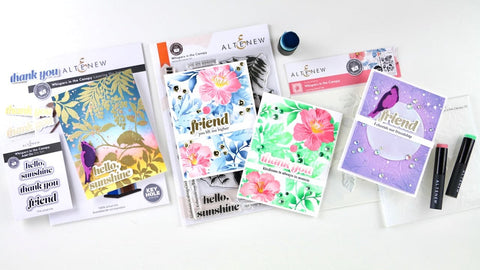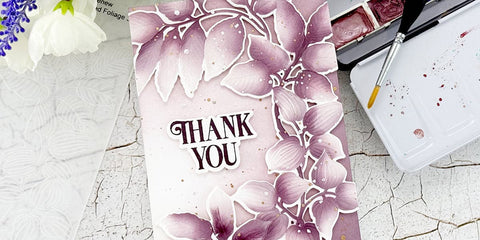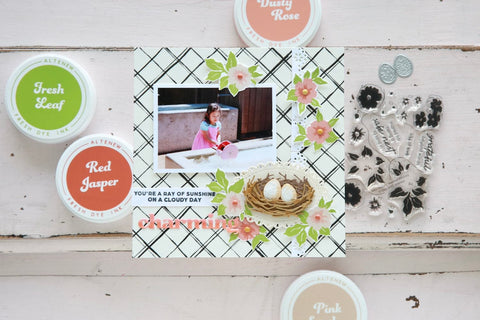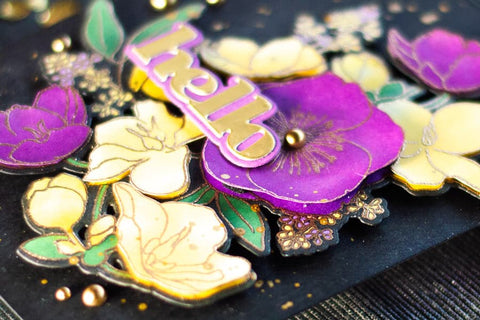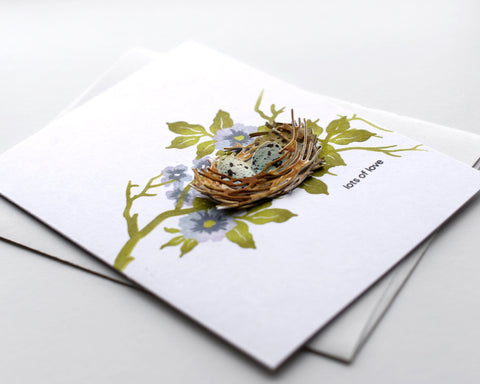Card Making Is Too Complicated and Time-Consuming (Let’s Debunk This Myth!)
Last Updated: July 1, 2025
Are you interested in getting into card making, but feel intimidated by the perceived complexity and time commitment? It's time to bust that myth! Card making doesn't have to be complicated or time-consuming. In fact, there are plenty of techniques that are easy to learn, and even simple cards can be absolutely stunning.
Check out this quick video on 5 Easy Card Making Ideas for Beginners
Let's take a quick trip to the world of card making and explore how you can create beautiful cards without advanced skills or a significant time investment.

Debunking the Myth: Card Making Is Too Complicated and Time-Consuming
|
Myth: Card making requires advanced skills and a significant time investment. Reality: Many card making techniques are easy to learn, and even simple cards can be quite beautiful. |
Card Making Techniques for Beginners
Diving into the world of card making can feel a bit overwhelming, especially with so many techniques to choose from. But don’t worry! Several beginner-friendly methods can help you create beautiful cards without stress. Let’s explore some of these techniques and address some common challenges you might face along the way.

1. Stamping
Stamping is one of the most fundamental and versatile techniques in card making. It’s perfect for beginners because it requires minimal supplies: just some stamps, inks, and paper. If you’re worried about making mistakes, start with clear stamps that allow you to see exactly where you’re placing the design. This way, you can practice without the fear of ruining your card. Plus, there are endless designs available, so you can easily find something that matches your theme or sentiment.

2. Die-Cutting
If you want to add a professional touch to your cards, consider investing in a die-cutting machine. These machines allow you to cut out intricate shapes and designs with precision. While it might seem daunting at first, many machines come with user-friendly instructions. Start with simple shapes to build your confidence.

3. Embossing
Embossing is a fantastic way to add texture and dimension to your cards, making them stand out. You can choose between dry embossing with a 3D embossing folder or heat embossing using embossing powder and a heat gun. If you’re new to this technique, dry embossing is often easier and requires fewer supplies. Just remember to practice on scrap cardstock first to get the hang of the pressure and technique. The tactile quality of embossed designs can really elevate your cards and impress your friends and family!

4. Stenciling
Stenciling is another fun technique that allows you to create beautiful patterns and designs easily. It’s perfect for those who may feel intimidated by freehand drawing. Simply place a stencil over your paper and apply ink or paint with a sponge or brush. If you’re worried about smudging, secure the stencil with low-tack tape to keep it in place. This technique is great for adding backgrounds or decorative elements without needing advanced skills.

5. Layering
Layering is a simple yet impactful technique that involves stacking different papers and embellishments to create depth and interest. It’s an excellent way to use up scraps and add personality to your cards. If you find yourself struggling with color combinations, try sticking to a color palette or using a monochromatic scheme to keep things cohesive. Don’t be afraid to experiment! Sometimes, the best designs come from trying something unexpected.

Card Making Layering Techniques
Layering is a key aspect of card making, and there are numerous ways to approach it. Here are some layering techniques to experiment with:
-
Matting and Layering


Step-by-Step Guide to Matting and Layering in Paper Crafting
Matting and layering is a straightforward yet impactful technique that can elevate your crafting projects. Follow these steps to beautifully frame your focal point and add depth to your creations.
- Step 1: Identify Your Focal Point
Begin by choosing the centerpiece of your project. This could be a decoupage image, a stamped or die-cut image, or a pre-printed graphic that inspires you.
- Step 2: Choose Complementary Papers
Select some cardstock or paper that complements your focal point. Look for colors and patterns that will enhance and highlight your chosen image.
- Step 3: Create the Mat
Now, it’s time to create the mat. Opt for a contrasting material to layer beneath your image. Bold hues, glittery finishes, or textured papers can create a striking backdrop.
- Step 4: Trim the Mat
Cut the mat slightly larger than your image—about 0.25 inches on each side. This will create a visually appealing frame that draws attention to your focal point.
- Step 5: Attach the Layers
Use your adhesive of choice to secure the image to the mat. For a sleek, flat appearance, glue tape works well. For added dimension, consider using foam pads. If you need flexibility in positioning, wet glue allows for adjustments before it dries.
- Step 6: Assemble Your Project
Continue layering as desired until you achieve your preferred look. Once you’re happy with the result, attach your framed focal point to a card, scrapbook page, gift tag, or any other papercraft project you’re creating.
-
Decoupage

Understanding Decoupage: A Beginner's Guide
If you’re new to card making, you might have come across the term "decoupage" or "3D decoupage" and wondered what it’s all about. Don’t worry—it’s simpler than it sounds, and it can add a delightful dimension to your creations!

At its core, decoupage is a creative technique that involves decorating an object by layering different materials like paper, fabric, or even gold leaf. In the context of card making, decoupage focuses on building a layered effect using various pieces of cardstock or decorative paper, often enhanced with three-dimensional adhesives.

Here’s how it works:
- Start by selecting your images or designs, which could be anything from floral patterns to whimsical illustrations.
- The beauty of decoupage lies in the layering—by cutting out multiple copies of the same image.
- Stack them with adhesive foam pads and voila! You’ve created a stunning 3D effect that brings your card to life!
What makes decoupage so accessible is that you likely already have many of the materials you need at home. You can use old magazines, wrapping paper, or any decorative paper you love. The process is straightforward: cut out your images, layer them strategically, and adhere them with a glue or adhesive that suits your project. Don’t let the term intimidate you! Decoupage is all about creativity and experimentation. It’s a fantastic way to personalize your handmade cards and make them truly unique.
-
Inlaid Die-Cutting

A Quick Guide to Inlaid Die-Cutting
If you’re looking to add a touch of texture and creativity to your card making, inlaid die cutting is a fantastic technique to explore! It might sound a bit complex at first, but once you get the hang of it, you’ll find it’s both fun and rewarding.

So, what exactly is inlaid die cutting?
- Start with a cardstock and your favorite die set.
- Use a die-cutting machine to cut out shapes.
- These shapes create negative spaces—think of them as puzzle pieces that are missing from the card.
- Die cut the same shapes out of different colored cardstock or patterned paper.
- The magic happens when you take the colored or patterned die-cut pieces and fit them back into those negative spaces. It’s like putting together a beautiful puzzle where each piece enhances the overall design!

This technique not only adds depth and interest to your cards but also gives you the chance to play with colors and patterns. You can mix and match to create stunning visual effects that will impress anyone who receives your card.
One of the best parts about inlaid die cutting is its versatility. Whether you want to create a bold, modern look or something more soft and whimsical, you can tailor it to fit your style. Plus, it’s a great way to use up those scrap pieces of paper you might have lying around!
Don’t worry if it feels a bit tricky at first. Like any new skill, practice makes perfect! Start with simple shapes and gradually experiment with more intricate designs as you gain confidence. Before you know it, you’ll be creating beautiful, inlaid masterpieces that showcase your creativity and flair.

Card Folding Techniques for Card Making
The way you fold your card can also add a unique touch to your designs. Here are a few simple folding techniques you can try!

- Gatefold: This style of card opens from the middle, creating a grand entrance for your message inside.
- Z-Fold: The Z-fold creates an interesting visual element and allows for multiple layers and decorations.

- Accordion Fold: Perfect for showcasing a series of images or creating a dynamic reveal as the card is opened. Reiko’s DIY project above showcases the accordion fold simply and beautifully!

Tips on How to Actually Make Cards
Now that you're familiar with some basic card making techniques, here are a few tips to help you actually make cards without feeling overwhelmed:
- Start Simple. Don't feel pressured to create elaborate designs right from the beginning. Simple cards can be just as beautiful and meaningful.
- Gather Essential Supplies. Invest in some basic supplies such as cardstock, adhesive, scissors, or paper trimmer, and a few versatile stamps, dies, and inks.
- Practice Consistently. Like any craft, practice is key. The more you practice, the more confident you'll become in your card making skills.
- Take Inspiration from Others. Don't be afraid to seek inspiration from other card makers. Browse through Pinterest, Instagram, or crafting blogs, or watch YouTube video tutorials for ideas and techniques.

Are Handmade Cards Better?
The debate between handmade and store-bought cards has been ongoing, but there's something undeniably special about receiving a handmade card. Here's why handmade cards are often considered better:
- Handmade cards are unique and carry a personal touch that store-bought cards simply can't replicate.
- When you make a card by hand, you have complete control over the design, colors, and message, allowing you to tailor it specifically to the recipient.
- The time and effort put into making a handmade card demonstrate thoughtfulness and care, making it all the more meaningful to the recipient.

Card Making Is Neither Complicated Nor Time-Consuming
Card making doesn't have to be complicated or time-consuming. With the right techniques, tips, and a bit of practice, you can create stunning DIY cards that will be cherished by your loved ones. Whether you're a beginner or have been crafting for years, there's always something new to learn in the world of card making. We hope this blog encouraged you to take that first step into the world of cardmaking. Enjoy the rewarding experience of making beautiful handmade cards for any occasion!
Visit us In the Craft Room for more card making tips, tricks, and ideas. Happy crafting!




